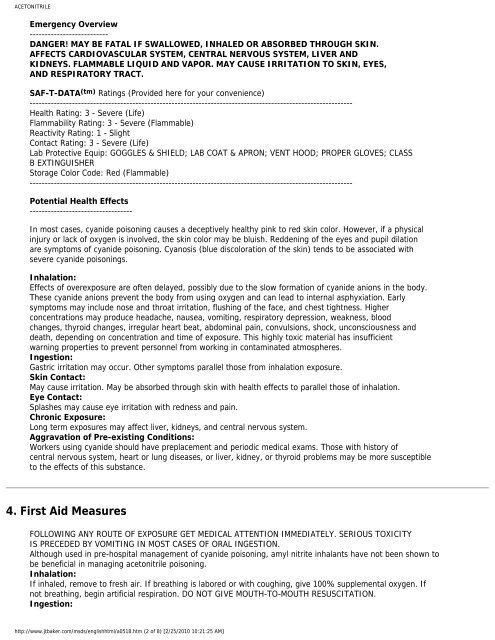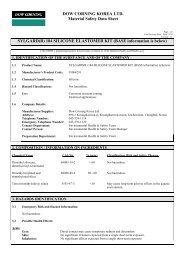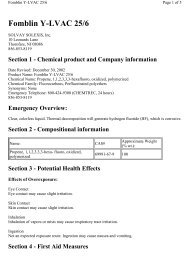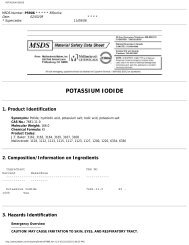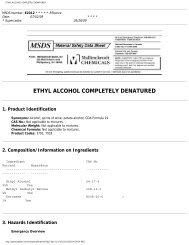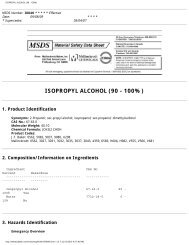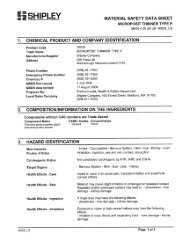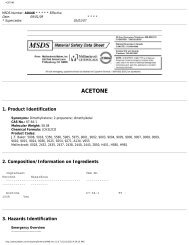ACETONITRILE
Acetonitrile (CH 3 CN) - Materials Characterization Facility
Acetonitrile (CH 3 CN) - Materials Characterization Facility
- No tags were found...
You also want an ePaper? Increase the reach of your titles
YUMPU automatically turns print PDFs into web optimized ePapers that Google loves.
<strong>ACETONITRILE</strong><br />
Emergency Overview<br />
--------------------------<br />
DANGER! MAY BE FATAL IF SWALLOWED, INHALED OR ABSORBED THROUGH SKIN.<br />
AFFECTS CARDIOVASCULAR SYSTEM, CENTRAL NERVOUS SYSTEM, LIVER AND<br />
KIDNEYS. FLAMMABLE LIQUID AND VAPOR. MAY CAUSE IRRITATION TO SKIN, EYES,<br />
AND RESPIRATORY TRACT.<br />
SAF-T-DATA (tm) Ratings (Provided here for your convenience)<br />
-----------------------------------------------------------------------------------------------------------<br />
Health Rating: 3 - Severe (Life)<br />
Flammability Rating: 3 - Severe (Flammable)<br />
Reactivity Rating: 1 - Slight<br />
Contact Rating: 3 - Severe (Life)<br />
Lab Protective Equip: GOGGLES & SHIELD; LAB COAT & APRON; VENT HOOD; PROPER GLOVES; CLASS<br />
B EXTINGUISHER<br />
Storage Color Code: Red (Flammable)<br />
-----------------------------------------------------------------------------------------------------------<br />
Potential Health Effects<br />
----------------------------------<br />
In most cases, cyanide poisoning causes a deceptively healthy pink to red skin color. However, if a physical<br />
injury or lack of oxygen is involved, the skin color may be bluish. Reddening of the eyes and pupil dilation<br />
are symptoms of cyanide poisoning. Cyanosis (blue discoloration of the skin) tends to be associated with<br />
severe cyanide poisonings.<br />
Inhalation:<br />
Effects of overexposure are often delayed, possibly due to the slow formation of cyanide anions in the body.<br />
These cyanide anions prevent the body from using oxygen and can lead to internal asphyxiation. Early<br />
symptoms may include nose and throat irritation, flushing of the face, and chest tightness. Higher<br />
concentrations may produce headache, nausea, vomiting, respiratory depression, weakness, blood<br />
changes, thyroid changes, irregular heart beat, abdominal pain, convulsions, shock, unconsciousness and<br />
death, depending on concentration and time of exposure. This highly toxic material has insufficient<br />
warning properties to prevent personnel from working in contaminated atmospheres.<br />
Ingestion:<br />
Gastric irritation may occur. Other symptoms parallel those from inhalation exposure.<br />
Skin Contact:<br />
May cause irritation. May be absorbed through skin with health effects to parallel those of inhalation.<br />
Eye Contact:<br />
Splashes may cause eye irritation with redness and pain.<br />
Chronic Exposure:<br />
Long term exposures may affect liver, kidneys, and central nervous system.<br />
Aggravation of Pre-existing Conditions:<br />
Workers using cyanide should have preplacement and periodic medical exams. Those with history of<br />
central nervous system, heart or lung diseases, or liver, kidney, or thyroid problems may be more susceptible<br />
to the effects of this substance.<br />
4. First Aid Measures<br />
FOLLOWING ANY ROUTE OF EXPOSURE GET MEDICAL ATTENTION IMMEDIATELY. SERIOUS TOXICITY<br />
IS PRECEDED BY VOMITING IN MOST CASES OF ORAL INGESTION.<br />
Although used in pre-hospital management of cyanide poisoning, amyl nitrite inhalants have not been shown to<br />
be beneficial in managing acetonitrile poisoning.<br />
Inhalation:<br />
If inhaled, remove to fresh air. If breathing is labored or with coughing, give 100% supplemental oxygen. If<br />
not breathing, begin artificial respiration. DO NOT GIVE MOUTH-TO-MOUTH RESUSCITATION.<br />
Ingestion:<br />
http://www.jtbaker.com/msds/englishhtml/a0518.htm (2 of 8) [2/25/2010 10:21:25 AM]


